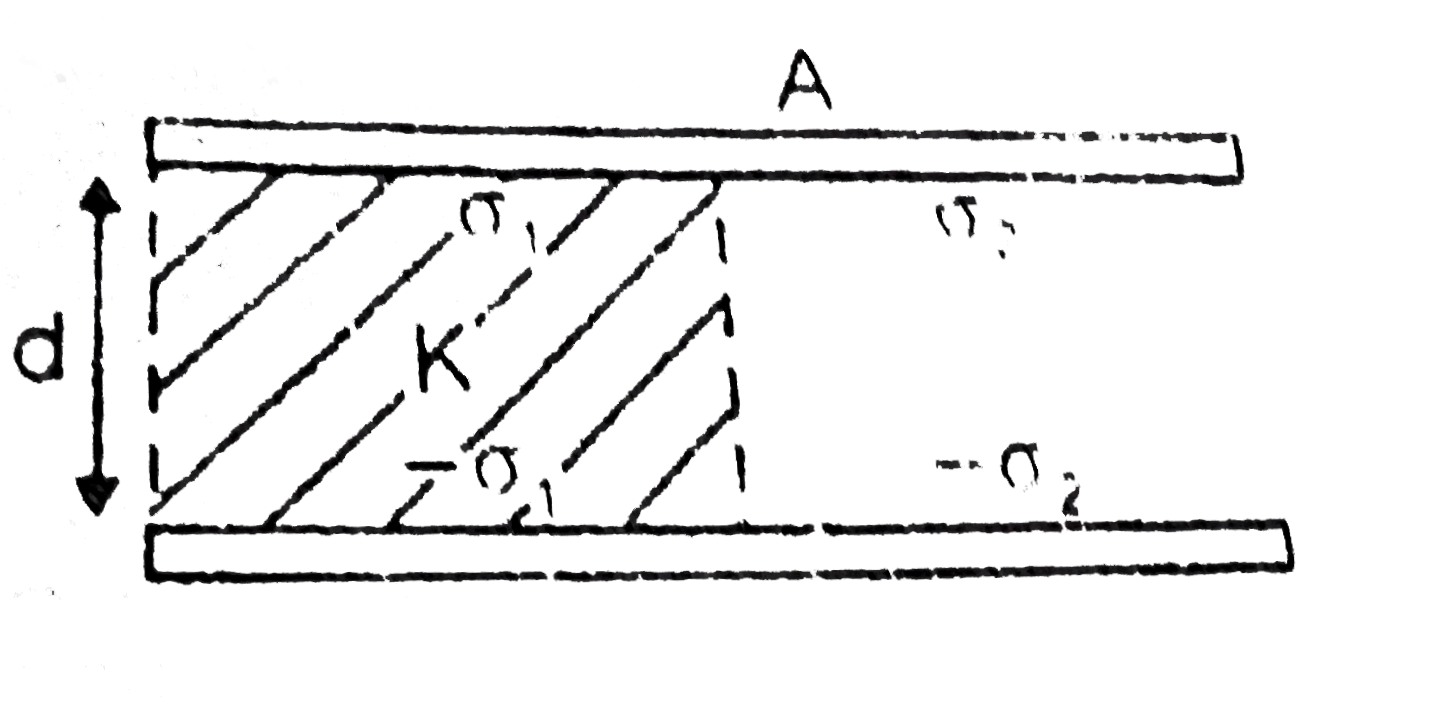A parallel plate capacitor of area A and separation d is charged to potential difference V and removed from the charging source. A dielectric slab of constant thickness d and area A2 is inserted, as shown in the figure. Let σ1 be free charge density at the conductor-dielectric surface and σ2 be the charge density at the conductor-vacuum surface. The incorrect statement is

The electric fields have different values inside the dielectric and in the free space between the plates
The ratio σ1σ2 is equal to 21
The new capacitance is 3ε0A2d
The new potential difference is 2V3
The correct Answer is:A
Potential V=σ1Kε0×d=σ2dε0⇒σ2=σ1K therforeσ1σ2=2
E1=E2 ∴σ1Kε0=σ2ε0,C=C1+C2=Kε0A/2d+ε0A/2d=3ε0A2d.
Similar Questions
A parallel plate capacitor having plate area A and separation between the plates d is charged to potential V.The energy stored in capacitor is ....???
View SolutionA parallel plate capacitor has plate of area A and separationd .It is charged to a potential difference V0 . The charging battery is disconnected and the plates are pulled apart to three times the initial separation.The work required to separate the plates is.
View Solution
Knowledge Check
A parallel plate capacitor of area A and separation d is charged to potential difference V and removed from the changing source. A dielectric slab of constant K =2, thickness d and are area A2 is inserted, as shown in the figure. Let σ1 be free charge density at the conductor-dielectric surface and σ2 be the charge density at the conductor-vacuum surface
 AThe electric field have same value inside the dielectric as in the free space between the platesBThe ratio σ1σ2 is equal to 21CThe new capcitance is 3∈0A2dDThe new potential difference is 23V
AThe electric field have same value inside the dielectric as in the free space between the platesBThe ratio σ1σ2 is equal to 21CThe new capcitance is 3∈0A2dDThe new potential difference is 23VA parallel plate capacitor is charged to a potential difference of 100V and disconnected from the source of emf. A slab of dielectric is then inserted between the plates. Which of the following three quantities change?
Aonly (i) and (ii)Bonly (i) and (iii)Conly (ii) and (iii)DAll (i),(ii) and (iii)A parallel plate capacitor has plates with area A and separation d. A battery charges the plates to a potential difference V0. The battery is then disconnected and a dielectric slab of thikness d is introduced. The ratio of the enrgy stored in the capacitor before and after the slab is introduced, is
AKB1KCAd2KDd2KA
A parallel plate capacitor , each with plate area A and separation d , is charged to a potential difference V . The battery used to charge it remains connected . A dielectric slab of thickness of and dielectric constant K is now placed between the plates . What change , if any , will take place in :
charge on plates ?
Justify your answer
View SolutionA parallel plate capacitor , each with plate area A and separation d , is charged to a potential difference V . The battery used to charge it remains connected . A dielectric slab of thickness of and dielectric constant K is now placed between the plates . What change , if any , will take place in :
electric filed intensity between the plates ? Justify your answer .
View SolutionA parallel - plate capacitor of plate area Aand plate separation d is charged to a potential difference V and then the battery is disconnected . A slab of dielectric constant K is then inserted between the plate of the capacitor so as to fill the space between the plate .Find the work done on the system in the process of inserting the slab.
View SolutionA parallel plate capacitor , each with plate area A and separation d , is charged to a potential difference V . The battery used to charge it remains connected . A dielectric slab of thickness of and dielectric constant K is now placed between the plates . What change , if any , will take place in :
capacitance of the capacitor ? Justify your answer .
View SolutionA parallel plate capacitor each with plate area A and separation ‘d’ is charged to a potential difference V. The battery used to charge it is then disconnected. A dielectric slab of thickness d and dielectric constant K is now placed between the plates. What change if any, will take place in
(i) charge on the plates
(ii) electric field intensity between the plates,
(iii) capacitance of the capacitor
Justify your answer in each case
View Solution
